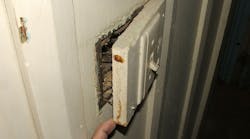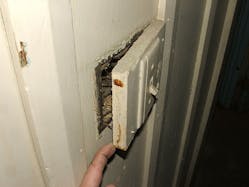How well do you know the Code? Think you can spot violations the original installer either ignored or couldn't identify? Here's your chance to moonlight as an electrical inspector and second-guess someone else's work from the safety of your living room or office. It's your turn to identify the violation.
Hint: “Wood” you do this?
Find the Answer
I discovered this wooden “extension ring” installed over a metal 2-gang device box. The terminals for the switch are now exposed directly to the combustible wood. This could be a real problem if any arcing or sparking occurred at these connections.
Flush-type snap switches must be mounted in boxes that are flush with the surface so that the yoke of the device is seated against the box in accordance with Sec. 404.10(B). Boxes set back from the finished surface are only permitted if the wall or ceiling is made of a non-combustible material such as concrete, tile, or plaster. Wood does not fall into this category. This box is not permitted to be installed “set back” from this finished wood surface. It must be flush with, or extend beyond the wood surface as required by Sec. 314.20. If the installer needed “extra space” in this box to accommodate the installation of this switch, he should have installed a listed extension ring or listed box extender.
Creative carpentry was not the correct solution to this problem. It created a dangerous Code violation.





